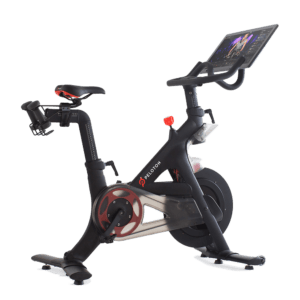Flywheel Anywhere: The Digitalization of Flywheel Sports

This posts examines how Flywheel Sports, an indoor cycling company, is responding to competition and the demand for digitalized wellness solutions.
When Ruth Zukerman co-founded Flywheel Sports, an indoor cycling studio, in 2010, her mission was: “…to create a workout that enabled all of our riders to elevate their performance – in the stadium and in life.”1 Seven years and 42 studios later, her vision has translated into a national (and even global)2 phenomenon. Powered by music, lights, and dynamic instructors, Zukerman helped Flywheel become a first mover in digitalizing the indoor cycling experience. After co-founding competitor SoulCycle, Zukerman created a technologically-enhanced workout that provided riders with metrics for speed and resistance, real-time in-studio competition, and the ability to track historical performance through an app. However, in the face of increasing digitalization and consumer demand for instant gratification, can Flywheel translate its mission further into the digital age?
I agree with Regis McKenna, author of Real Time: Preparing for the Age of the Never Satisfied Customer, that Flywheel must try. McKenna writes, “Management must be prepared for the eventuality of anything-anytime, anywhere.”3 In this respect, Flywheel faces a formidable competitor in Peloton. Co-founded in 2012 by John Foley (HBS ’01), it allows consumers to purchase their metric-based proprietary bike and live-stream or watch recorded workouts. Peloton also solves the limited-capacity studio issue as thousands of riders can simultaneously ride and interact with other users. Despite a cost of $1,995 per bike plus a monthly subscription fee4, the value proposition of convenience has helped Peloton soar to unicorn valuation.5 For Flywheel, Peloton poses a legitimate threat because it creates the opportunity for virtual fitness to cannibalize studio business. As a result, Flywheel must find a way to offer a digital value proposition.

With increased competition and demand for digital wellness solutions, Flywheel announced its own at-home product, “Flywheel Anywhere,” in May 2017, with launch planned for that November. Flywheel Anywhere will feature streaming and recorded rides.6 Unlike Peloton, Anywhere will allow users to utilize their own electronic devices with the bike. According to Flywheel purchasing analyst Alex Garson, the company expects that in the short-term, demand will be generated largely from the 19 geographical areas where Flywheel has a studio presence. In the medium-term, Flywheel hopes Anywhere will generate business in new markets (for example, the American Midwest).7 With the virtual fitness trend still emerging,8 Flywheel’s strong studio brand coupled with a digital presence may help the company capitalize on new growth in the digital fitness industry.

Digitalizing the Flywheel experience poses several key logistical challenges to integrated planning and execution. For example, whereas the supply chain process was relatively simple for studios, Anywhere requires new adjustments. Flywheel is not as vertically integrated as Peloton.6 After making proprietary adjustments to bikes manufactured by ICG,9 each studio receives a specified number of bikes that are serviced by trained Flywheel staff. Flywheel Anywhere, however, will require the integration of distribution company XPO into the Flywheel supply chain. In preparation for the release, Flywheel has coordinated 42 XPO distribution centers throughout the US to help deliver, set up, service, and warehouse bikes.7
In tandem with adjusting the supply chain, forecasting demand requires art and science. Following the May announcement, Flywheel’s purchasing department worked with marketing and financing to forecast an initial number of bikes to order based on the number of inquiries the company fielded.7 However, it will be difficult to develop a demand plan following the release of the new product for some time. Although committed to a roughly 90-day rolling forecast to ICG, longer lead times further complicate determining inventory.
As Flywheel Anywhere becomes an increasingly important part of the business model, it will be important to have a transparent logistics platform that integrates information between Flywheel, ICG, and XPO. Stefan Schrauf and Philipp Bertram of PWC argue, “the key to success for any supply chain is the efficient exchange of information…any outsourcing of many necessary elements only makes it harder to understand the supply chain in full.”10 By having a closely connected supply chain with heightened visibility, Flywheel will be able to better communicate demand and attend to customer support issues. To further differentiate itself, Flywheel could also consider integrating its complementary workout, FlyBarre, onto the Anywhere platform. Not only will this offer a diversified workout platform, but barre materials (typically a ball, resistance band, small weights) are cheaper and likely easier to deliver. However, Flywheel will also need to consider whether ordering more equipment could add more complexity to its new supply chain.
Flywheel Sports is excited about its next venture. However, will the company be able to gain meaningful market share against existing competition and should it have initiatives beyond Anywhere? Does having outsourced aspects of its supply chain hinder its ability to respond to demand? Perhaps most importantly, can Flywheel Anywhere truly translate Zukerman’s vision for the studio workout experience to homes world-wide?
(Word Count: 793)
Footnotes:
1 Zukerman, Ruth . “About Flywheel Sports,” www.flywheelsports.com/about, accessed November 2017.
2 Flywheel Sports operates two studios in Dubai.
Flywheel Sports, “Home,” https://www.flywheelsports.com/, accessed November 2017.
3Regis McKenna, Real Time: Preparing for the Age of the Never Satisfied Customer (Boston: Harvard Business School Press, 1997), https://dl.acm.org/citation.cfm?id=523019&CFID=829122912&CFTOKEN=83592015, accessed November 2017.
4 In addition to the cost of the Peloton bike, $1,995, there is an additional $250 setup cost and $39 monthly subscription fee.
Peloton, “Shop,” https://www.onepeloton.com/shop/bike, accessed November 2017.
5 Zakrzewski, Cat, “Investors Bet on Unicorn for Spinning Classes,” Wall Street Journal, May 24, 2017, https://www.wsj.com/articles/investors-bet-on unicorn-for-spinning-classes-1495625403, accessed November 2017.
6 Kauflin, Jeff, “Why Your Next Spin Class Could Be In Your Living Room.” Forbes, May 17, 2017, https://www.forbes.com/sites/jeffkauflin/2017/05/17/why-your-next-spin-class-could-be-in-your-living-room/#1576c8d93d97 , accessed November 2017.
7 Interview with Flywheel Sports Purchasing Analyst Alex Garson, Phone Interview, November 13th, 2017.
8 According to this source, only ~15% of consumers regularly paid for a fitness subscription in 2016.
Dawson, Gloria, “Spin Class Full? Feel the Burn From Your Living Room,” New York Times, September, 17, 2016, https://www.nytimes.com/2016/09/18/business/spin-class-full-feel-the-burn-from-your-living-room.html, accessed November 2017.
9 Indoor Cycling Group (ICG) is a major indoor cycling manufacturer. It is owned by leading fitness equipment company, Life Fitness.
“Life Fitness Plans to Add Indoor Cycling Group to Its Brand Portfolio,” Life Fitness press release (Rosemont, IL, July 28, 2016).
10 Schrauf, S. and P. Berttram, Industry 4.0: How Digitization Makes the Supply Chain More Efficient, Agile, and Customer Focused, PWC Strategy& (2016).



Thanks for a great post! I agree with your assessment that Flywheel Anywhere presents both challenges and opportunities:
• In terms of opportunities, there seems to be significant upside in terms of scalability in offering an at-home Flywheel experience. Rather than holding a class with fifty people, Flywheel can now offer classes that reach hundreds or thousands of people at once. The challenge comes in driving bike purchases, which require the customer to make upfront investment to experience Flywheel Anywhere. I think this is where Flywheel can leverage its brand awareness in the marketplace over other competitors to convince customers that their excellent studio experience will translate to a similarly excellent at-home workout.
• As you mentioned in your post, there are meaningful challenges with translating the studio workout experience to a home workout. This includes whether the equipment is properly set up and utilized throughout the workout (for example, is the bike adjusted correctly for the rider) and inherent differences between working out in a studio in a group setting versus at home individually. By offering Flywheel Anywhere, I wonder whether the inherent difference between the studio experience and the at-home workout risks diluting or changing Flywheel’s brand image in the mind of the public.
HeidiRoizensUncleHoward, as a spin fan in general and Flywheel fan specifically, I really enjoyed reading this article. Before reading this, I assumed that you would be discussing Flywheel’s digitized customer experience in the in-class scoreboard and on-bike metrics. However, while Flywheel was clearly a leader in comparison to SoulCycle in this in-studio digitization, your article astutely points out that Flywheel has lagged Peloton in the at-home digitization of the workout experience. First, I wonder how Flywheel missed this opportunity? Did they perhaps become complacent with their in-studio leadership and forget to really speak to their customers? If they had, perhaps they would have recognized the opportunity for a truly great at-home workout experience. As we saw in our IDEO case, it is critical for companies to constantly rejuvenate and reassess their customer needs so as to not be disintermediated. That being said, I do not think it is too late for Flywheel. While Peloton leads at-home workout experiences, Flywheel Anywhere can still leverage the Flywheel competitive advantage of using data to track your personal scores and compete against others. Perhaps Flywheel customers want targeted feedback for improvement based on their personal data or they want to be able to race friends with Flywheel Anywhere bikes. Flywheel also should take the IDEO approach of looking outside their industry for innovative uses of data that can be applied to the home workout space. Furthermore, why stop at spin and barre? The data tracking concept could be easily applied to treadmills, rowing and beyond. Looking forward to seeing how Flywheel Anywhere expands in the future!
In a digital world, it’s crazy to think that even the way we work out which is a highly physical activity will be significantly affected by this. But this play by Flywheel in an interesting response honestly. Not sure it’s quite in their wheelhouse (pun intended) to expand their business model to include this individual home model already.
I’m thinking they should focus on their current business model and expand their geographical footprint before taking on peloton just yet especially as people are spending more money/time on “experiences” and that includes going to fitness classes. Most of the fun is in experiencing it with others. The Peloton (individual rider market) is likely a much smaller market. That being said, I’m impressed by their willingness to expand and make sure they aren’t being disrupted by the likes of Peloton. Never know where things will go as AR/VR technology expands. Maybe we’ll all just work out from home but with each other through our VR system.